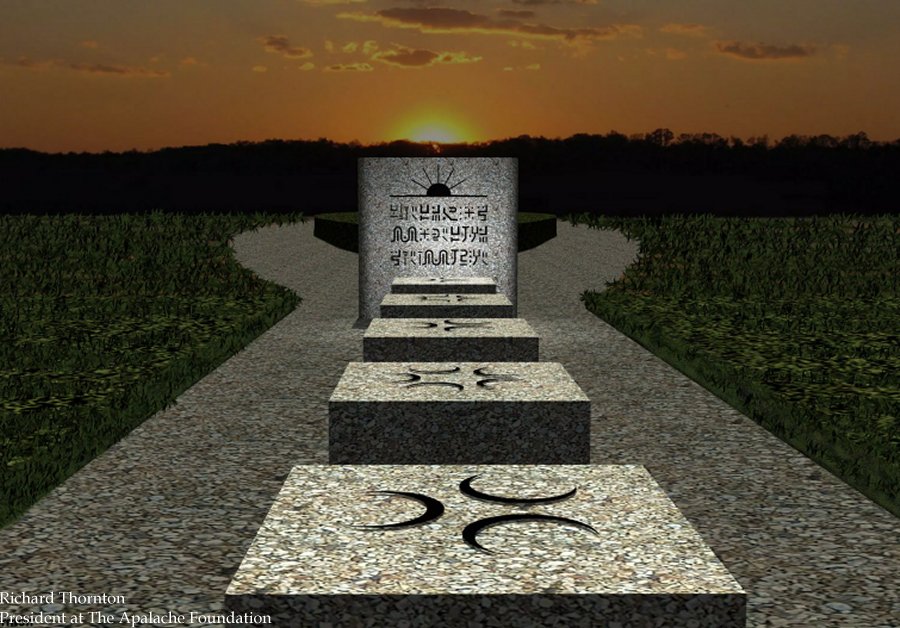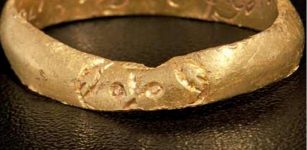Mysterious Yamacutah – A Sacred Native American Indian Shrine
Jan Bartek - AncientPages.com - Mystery surrounds the Yamacutah, a sacred Native American shrine located along the North Oconee River in Jackson, County, Georgia, where Indians believed the Great Spirit once walked.
According to Apalache tradition, one day, when the Master of Breath was standing on a hilltop, he disappeared before their eyes. The place where he disappeared was developed into a shrine with stone monuments engraved with galactic symbols and the new Apalache writing system.

When the first newcomers began settling the interior of the Southeast the Yamacutah was still used, but what happened later is unclear.
The story of Yamacutah might have been lost in time if not for the documentation by local historian Gustavus James Wilson, who wrote of the shrine in his book “The Early History of Jackson County.” Wilson, 1827-1909, lived in Jefferson at the time he wrote the history.
According to Commerce resident Becky Perry, there is a lot of disagreement on where it is. Perry, is a member of the Tumbling Waters Society, a group working to preserve the history and natural environment of Hurricane Shoals Park, which is located along the North Oconee River in the general vicinity of where the shrine may have been located.
She believes the sacred place will be found as recent efforts have been conducted to find remnants of the shrine. The Creek Indians protected the site until 1785, when a treaty was signed that ceded the lands to white settlers.
From Wilson's book, we learn of two men who traveled from Virginia to Georgia in 1784. The explorers Jordan Clark and Jacob Bankston heard of Yamacutah from a group of Choctaw Indians in Wilkes County, and upon searching for the shrine, they found it on April 22, 1784.
They described a statue set atop an earthen mound about 6 feet high and 17 feet in circumference. The statue had a head that “was well-formed. The neck was unduly long and slender. The chin and forehead were retreating. Their eyes were finely executed and looked anxiously to the east.” Four smooth paths led in four directions from the statue. “And here, amid those gloomy solitudes, the natives believed that our God, their Great Spirit, had walked as a man walks along his homeward pathway.”
The mound was in the center of a circular landscape that measured 150 yards in diameter. There were other rock monuments carved with designs such as moons and the sun.
Surrounding the holy grounds were the giant hardwoods and pines of a virgin forest. Thornton, a Creek Indian, said he once considered Yamacutah a myth.

“I didn’t even know the name Yamacutah. I just knew there was some mystical place where God came down to earth. I thought it was some tall story from my grandmother, ” said Thornton, who has studied Indian history and was an architect for a Trail of Tears Memorial in Oklahoma.
The details that guide searchers like Thornton for Yamacutah are only found in Wilson’s book.
Wilson’s book also records that in 1785, there was a bitterly cold winter in which wildlife froze to death and a day of darkness in which the sun, while visible, gave no light as it appeared hidden by fog.
Thornton said that these conditions actually happened due to volcano eruptions in Iceland. “The finding of Yamacutah would be far-reaching beyond the borders of Jackson County. It’s a treasure for Georgia.” Thornton said.
Many still think Yamacutah is a real place, not a legend.
Updated on January 27, 2024
Written by Jan Bartek - AncientPages.com Staff Writer
More From Ancient Pages
-
 Immortal God Anubis: Lord Of The Sacred Land, Jackal God Of Mummification
Egyptian Mythology | Sep 19, 2016
Immortal God Anubis: Lord Of The Sacred Land, Jackal God Of Mummification
Egyptian Mythology | Sep 19, 2016 -
 Circular-Shaped 4000-Year-Old Wooden Henge Discovered In Yorkshire, Historic County of Northern England
Archaeology | Jan 3, 2018
Circular-Shaped 4000-Year-Old Wooden Henge Discovered In Yorkshire, Historic County of Northern England
Archaeology | Jan 3, 2018 -
 On This Day In History: Statue Of Venus de Milo Is Discovered On The Aegean Island Of Milos – On Apr 8, 1820
News | Apr 8, 2016
On This Day In History: Statue Of Venus de Milo Is Discovered On The Aegean Island Of Milos – On Apr 8, 1820
News | Apr 8, 2016 -
 King Geirrod Betrayed His Brother Agnar And Sent Him To Die But Justice Finally Prevailed
Featured Stories | Feb 14, 2024
King Geirrod Betrayed His Brother Agnar And Sent Him To Die But Justice Finally Prevailed
Featured Stories | Feb 14, 2024 -
 170-Million-Year-Old Sea Monster Identified As The Oldest Mega-Predatory Pliosaur
Evolution | Oct 23, 2023
170-Million-Year-Old Sea Monster Identified As The Oldest Mega-Predatory Pliosaur
Evolution | Oct 23, 2023 -
 Europe’s Earliest Culture Of Aurignacian People Made Amazing Images With Dots
Archaeology | Mar 5, 2017
Europe’s Earliest Culture Of Aurignacian People Made Amazing Images With Dots
Archaeology | Mar 5, 2017 -
 Skulls and inscriptions on three rings found by archaeologists in Wales
Artifacts | Aug 29, 2015
Skulls and inscriptions on three rings found by archaeologists in Wales
Artifacts | Aug 29, 2015 -
 Beautiful Legend Of Giant Olentzero Who Brings Christmas Presents To Basque Children
Christmas Traditions | Dec 19, 2024
Beautiful Legend Of Giant Olentzero Who Brings Christmas Presents To Basque Children
Christmas Traditions | Dec 19, 2024 -
 On This Day In History: William I ‘The Lion’ Was Crowned At Scone – On Dec 24, 1165
News | Dec 24, 2016
On This Day In History: William I ‘The Lion’ Was Crowned At Scone – On Dec 24, 1165
News | Dec 24, 2016 -
 Mysterious Undeciphered Ripley Scroll And Its Connection To The Philosopher’s Stone
Featured Stories | Mar 26, 2025
Mysterious Undeciphered Ripley Scroll And Its Connection To The Philosopher’s Stone
Featured Stories | Mar 26, 2025 -
 Magnificent Hattusa: Capital Of The Hittite Empire
Civilizations | Apr 11, 2021
Magnificent Hattusa: Capital Of The Hittite Empire
Civilizations | Apr 11, 2021 -
 Mysterious Skull Cult At Göbekli Tepe – Ancestor Worship Or Trophies Of Dead Enemies?
Archaeology | Jul 25, 2017
Mysterious Skull Cult At Göbekli Tepe – Ancestor Worship Or Trophies Of Dead Enemies?
Archaeology | Jul 25, 2017 -
 Death Of Kvasir And How Famous Mead Of Poetry Was Created, Stolen And Finally Recovered By Odin
Featured Stories | Apr 14, 2018
Death Of Kvasir And How Famous Mead Of Poetry Was Created, Stolen And Finally Recovered By Odin
Featured Stories | Apr 14, 2018 -
 Outstanding Discovery Of Unique Swords From The Viking Age Near Gausel Queen’s Grave
Archaeology | Jun 3, 2022
Outstanding Discovery Of Unique Swords From The Viking Age Near Gausel Queen’s Grave
Archaeology | Jun 3, 2022 -
 Mysterious Underground City In Brazil Could Re-Write Ancient History – Unexplained Artifacts And Skeletons – Part 1
Ancient Mysteries | Jan 23, 2022
Mysterious Underground City In Brazil Could Re-Write Ancient History – Unexplained Artifacts And Skeletons – Part 1
Ancient Mysteries | Jan 23, 2022 -
 Senegambia’s Circles: Largest Cluster Of Megalithic Structures Of Lost Civilization On Earth
Featured Stories | Jan 3, 2020
Senegambia’s Circles: Largest Cluster Of Megalithic Structures Of Lost Civilization On Earth
Featured Stories | Jan 3, 2020 -
 Hades – ‘The Unseen’ God Of The Dead, Fertility, Wealth And Earth’s Minerals
Featured Stories | Jun 2, 2020
Hades – ‘The Unseen’ God Of The Dead, Fertility, Wealth And Earth’s Minerals
Featured Stories | Jun 2, 2020 -
 Meenakshi Temple Of Madurai Is Among Most Powerful Sacred Sites For Hindu People
Featured Stories | Apr 29, 2021
Meenakshi Temple Of Madurai Is Among Most Powerful Sacred Sites For Hindu People
Featured Stories | Apr 29, 2021 -
 Mythical Beautiful Adarna Bird And Its Harmful Magical Power In Mythology Of Philippines
Myths & Legends | Jan 25, 2017
Mythical Beautiful Adarna Bird And Its Harmful Magical Power In Mythology Of Philippines
Myths & Legends | Jan 25, 2017 -
 How Far South Did Prehistoric Highly Skilled Polynesian Seafarers Sail?
Archaeology | Nov 1, 2024
How Far South Did Prehistoric Highly Skilled Polynesian Seafarers Sail?
Archaeology | Nov 1, 2024
